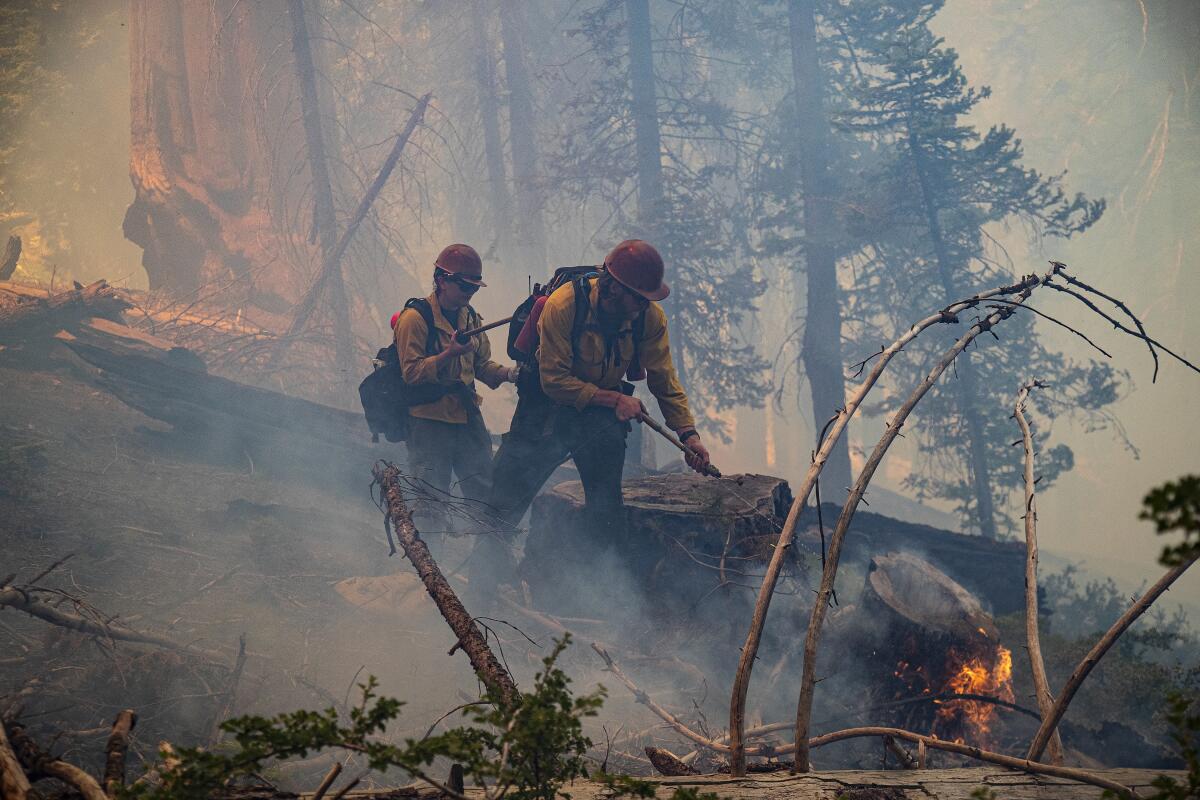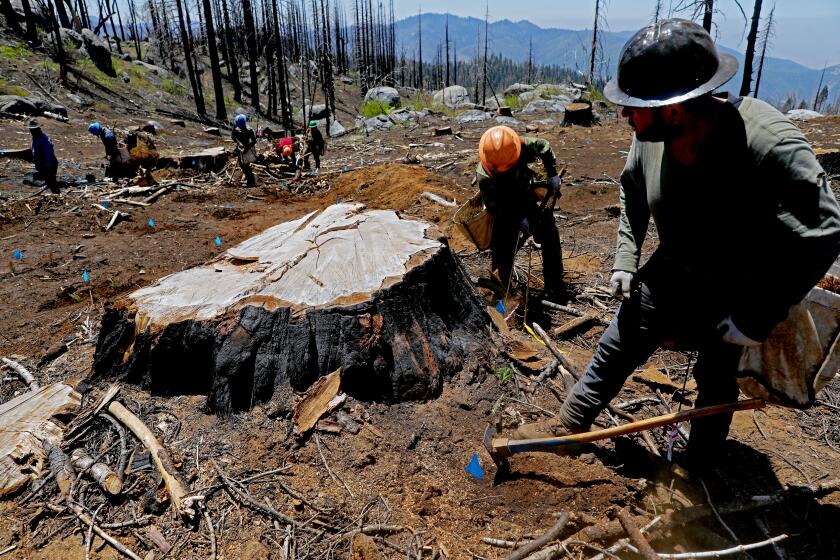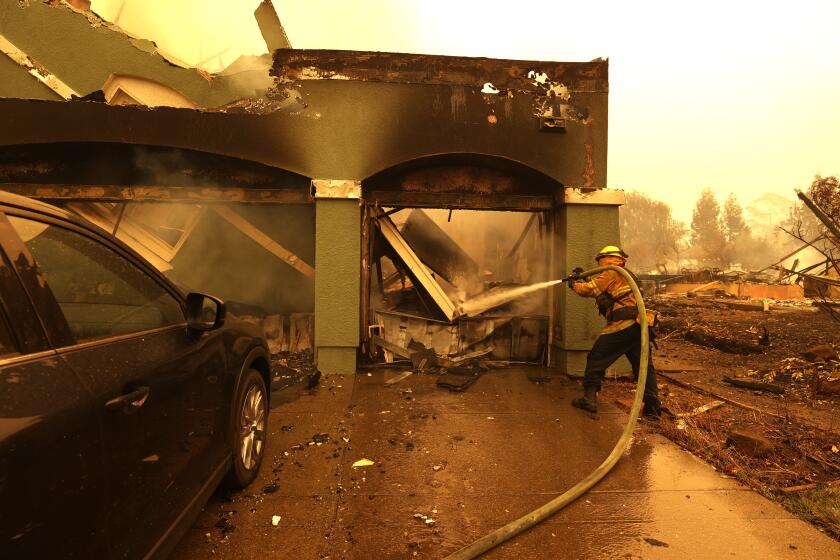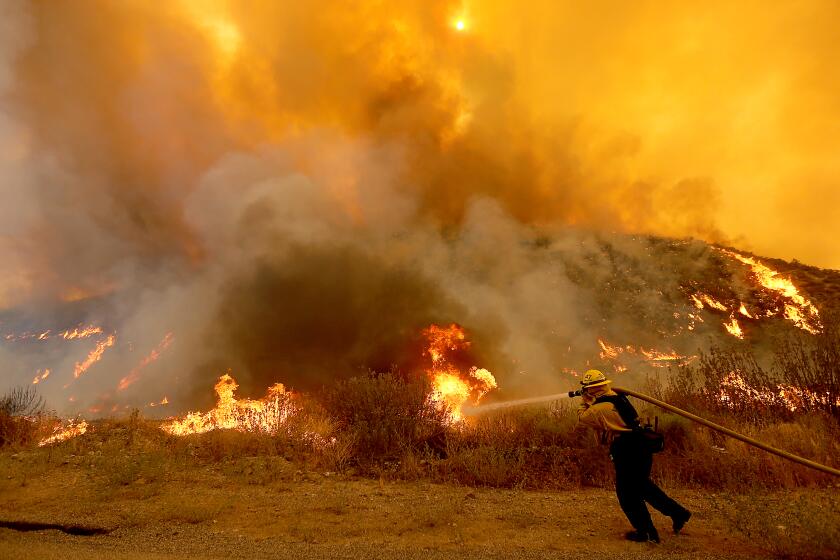Can a $20-million liability fund encourage more ‘good fire’ in California?

- Share via
As California grapples with increasingly destructive wildfires due in part to climate change, many experts insist that the state must fight fire with fire and expand the use of controlled burns to clear forests of excess fuel and restore ecosystem health.
However, a key barrier to purposely setting fire to forest vegetation has been the inability to obtain insurance coverage for burn operations.
Now, a new state program seeks to solve that problem by establishing a $20-million claims fund to cover damages should a controlled burn escape.
“We call this good fire, beneficial fire,” said state Sen. Bill Dodd (D-Napa), who sponsored legislation creating the fund. “It reduces hazardous fuels, which really create the volatility of these fires, particularly with wind and hot days and low humidities.”
Crews recently planted 30,000 giant sequoia seedlings in the western Sierra, as part of an ongoing effort to restore groves devastated by wildfire.
“Good fire” can refer to prescribed burning — the practice of setting land alight under optimal conditions to reduce vegetation that could fuel a catastrophic wildfire — or cultural burning — the controlled application of fire to achieve cultural goals or objectives set by Indigenous practitioners.
Cultural burning was practiced in California for millenniums before colonizers forced Native people from their lands and adopted policies to aggressively suppress both intentionally and naturally sparked blazes. Forests that had become adapted to fire grew denser, less diverse and more flammable — particularly as climate change made conditions hotter and drier.
The state is now seeking to restore the historical balance by encouraging more intentionally set fires and has set a goal of 400,000 acres a year by 2025.
“We really need to restore fire as a process on our California landscape,” said Lenya Quinn-Davidson, director of the University of California Agriculture and Natural Resources Fire Network and a member of the working group that developed the pilot program.
Private liability insurance that would cover these burns is prohibitively expensive or unavailable, putting the people overseeing them on the hook for potential damage costs. Although the U.S. Forest Service estimates the rate of escape to be less than 1%, the liability is a deterrent to doing more of the work.
Crews recently planted 30,000 giant sequoia seedlings in the western Sierra, as part of an ongoing effort to restore groves devastated by wildfire.
The liability claims fund, which was rolled out recently, provides up to $2 million in coverage for up to 200 projects at a time. In order to qualify, burns must be led by a certified burn boss or a cultural fire practitioner. By Friday afternoon, 20 projects had applied and 17 had been approved.
“For prescribed fire practitioners, it’s a huge deal,” said Len Nielson, the prescribed fire and environmental staff chief at the California Department of Forestry and Fire Protection, or Cal Fire, who is in charge of greenlighting the applications. “We are doing something brand new in hopes that it ends up with a real positive change for prescribed burning and cultural burning.”
The pilot, set to expire in 2028, will also enable the state to gather information about the rates of escape and damage, as well as the benefits of burns, he said. That may eventually alleviate the need for the program altogether.
“We want to show insurers that it is a low risk type of event when a certified burn boss or cultural burner conducts a prescribed burn or cultural burn,” Nielson said. “And so if we can document that with the data, then we’re hoping that attracts the insurers back to the marketplace in California.”
California’s biggest seller of homeowners insurance says regulations and wildfires make new policies a financial loser. But there are reasons to question that explanation.
The working group that developed the program guidelines also included representatives of Indigenous tribes, the state Department of Insurance, the Nature Conservancy and trade associations.
One stumbling block they had to overcome was that the legislation creating the program states that each project chief must submit a burn plan for review and approval by Cal Fire in order to qualify. But cultural practitioners often don’t use burn plans, and requiring them to do so would infringe on tribal sovereignty.
So the group came up with a compromise: cultural practitioners can instead include a description of the burn in their application.
“It’s still not perfect,” said Don Hankins, a professor at Cal State Chico and cultural burn practitioner. “What we tried to come up with is some language where people could basically say what the conditions would be like when they’re burning.”
Ron Goode, chairman of the North Fork Mono tribe and a cultural burn boss, was also involved in the talks. He said the compromise is a good start, but more needs to be done to overcome the racist legacy of laws that targeted Indigenous people who use fire.
“Even today, I have elders and tribal people who tell me, I shouldn’t be burning because we’re going to get in trouble with the government simply because they know what happened when their grandparents put fire on the ground,” he said. “So these kinds of rules and laws that the colonists and settlers put forward when they first got here are still in effect as far as how people feel about it.”
Between 1996 and 2020, wildfire burn areas in California grew five times larger than in the 25 years prior. Scientists say climate change is to blame.
The program builds on the work of several other key pieces of legislation that have put California on a trajectory to become a leader in the use of good fire. A bill passed in 2018 mandated the development of a state-certified burn boss program.
In 2021, California changed its liability standard so that people overseeing prescribed and cultural burns would in most cases not be billed for fire suppression costs if a burn were to escape control. That legislation also exempted cultural practitioners from needing to have a written prescription, a key element of a burn plan, approved by a certified burn boss in order to meet the liability standard.
Another bill introduced by Dodd would enable the secretary of the California Natural Resources Agency to enter into agreements with federally recognized tribes to exempt them from some state permitting and regulatory requirements related to cultural burning. It would also establish a cultural burn working group.
Dodd, who has sponsored roughly a dozen wildfire resilience bills, said he was spurred to action in 2017, when he was evacuated from his Napa home as the Atlas and Tubbs fires ravaged the county. When the smoke cleared, many of his neighbors had lost their homes, he said.
“It really shifts your view,” he said. “I never expected in my wildest imagination that all things wildfire, Cal Fire, fire suppression, fire prevention, insurance, utility caused fires — all these different things were not even part of my legislative work at all. And then overnight, that all changed.”
There is still more work to be done in order for California to meet its burning goals. Several experts identified the No. 1 remaining hurdle as training and workforce development, including empowering communities, tribes and underrepresented groups to be a part of the work.
Quinn-Davidson is also part of an interagency group working to develop a proposal for a prescribed fire training center, which was mandated by legislation passed in 2021.
“We can pour money into these issues but if we don’t have people to do the work, we’re not taking it where we need to go,” she said. “That’s going to be my focus for the next couple years.”
More to Read
Sign up for Essential California
The most important California stories and recommendations in your inbox every morning.
You may occasionally receive promotional content from the Los Angeles Times.














